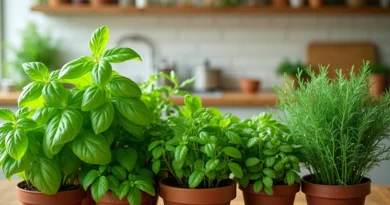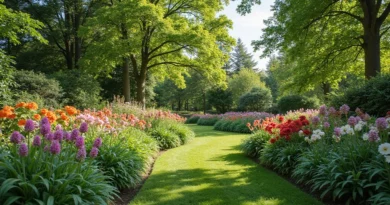How to Create a Vibrant Flower Garden: Design Tips for Every Season
Creating a vibrant flower garden is more than just digging a few holes and planting seeds; it’s an art form! Picture a patchwork of colors dancing in the wind, a sensory delight that changes with the seasons. With the right flower garden design, you can transform any space into a blooming paradise that tells a story throughout the year. From bright spring blooms to rich autumn hues, each season offers a unique palette and personality. Not only will your garden look stunning, but it will also attract pollinators and provide a haven for wildlife. Let’s dive into some fantastic design tips that will help you create a flourishing garden at any time of the year!
1. Embrace the Color Wheel

Understanding color schemes can significantly enhance the beauty of your flower garden. Warm colors, like reds and yellows, create an inviting atmosphere, while cool colors, such as blues and purples, evoke calmness. Seasonal blooms, when paired thoughtfully, can create stunning contrasts and harmonies.
– Monochromatic schemes: Use varying shades of one color for a sophisticated look, such as deep burgundies with soft pinks.
– Analogous schemes: Choose neighboring colors on the color wheel for a pleasing blend, like orange, yellow, and red for a fiery summer palette.
– Complementary schemes: Pair opposites for a dynamic vibe, such as yellow sunflowers against purple irises.
Play around with these ideas and consider the flowering times of each plant to ensure a continuous bloom throughout the seasons. You will be amazed at how a simple color choice can elevate your garden’s design!
2. Choose Perennials for Longevity

Perennials are staples in any flower garden due to their ability to return year after year. They provide a reliable foundation for your garden’s design and can be combined with annuals for continuous blooms.
– Popular choices: Consider classic favorites like daylilies, peonies, and coneflowers. Each has its own bloom period, which allows for a beautifully staged flower show.
– Planting depth: Ensure you plant perennials at the right depth to maximize their growth potential.
– Spacing: Group similar perennials together to create a natural flow and visual interest while maximizing their seasonal performances.
By incorporating perennials, you not only save time and effort each planting season but also add structure and versatility to your garden’s design.
3. Incorporate Seasonal Blooms

Adjusting your flower garden design with seasonal blooms can keep your garden fresh and exciting. Each season brings different floral attractions that can create a vibrant tapestry through the year.
– Springtime bursts: Plant tulips, daffodils, and hyacinths to welcome warmer weather.
– Summer showstoppers: Incorporate sunflowers, zinnias, and cosmos for splashes of color and height.
– Autumn richness: Opt for chrysanthemums, asters, and ornamental grasses to enrich your garden with warm tones.
– Winter interest: Use evergreen foliage and winter-blooming plants like hellebores to ensure something is always captivating.
Plotting out a calendar of blooms based on their peak times can help you plan an eye-catching succession of blooms all year!
4. Layering Heights for Depth

An intriguing flower garden design incorporates layers of different plant heights, which adds depth and visual interest. Tall plants in the back, medium ones in the middle, and shorter varieties at the front can create a stunning, three-dimensional effect.
– Background giants: Use tall plants like hollyhocks or delphiniums as a backdrop to draw the eye upwards.
– Mid-level charm: Place medium shrubs like lavender or salvia in the center for a fragrant, lush appearance.
– Ground hugging: Finally, low-growing flowers like creeping thyme or pansies can fill in gaps and soften edges.
This thoughtful layering draws visitors into your garden while letting each flower shine in its own light.
5. Mix in Foliage Plants

Foliage is just as crucial as flowers in a vibrant garden! Adding different textures and shades of green can elevate the overall visual appeal of your flower garden design.
– Variety of textures: Combine shiny, broad-leaved plants like hostas with finer-leaved varieties such as ferns.
– Color contrasts: Use foliage plants with unique colors, like purple heucheras, to add another layer of interest.
– Seasonal interest: Select evergreens to provide year-round color, ensuring your garden looks alive even in winter.
Foliage plants can function as a stunning backdrop to your flowers while providing seasonal diversity.
6. Create Garden Zones

Dividing your flower garden into zones can help manage the aesthetics and functionality of your space. Think of various areas that can serve different purposes or styles.
– Relaxation zone: Create a quiet spot with benches surrounded by fragrant blooms.
– Vegetable-flower combo: Incorporate edible blooms like nasturtiums alongside your flowers for a unique twist.
– Wildflower area: Introduce a section dedicated to native wildflowers, attracting pollinators and enhancing biodiversity.
By zoning your garden, you can create distinct areas that tell their own stories while still being part of the overarching design.
7. Add Garden Art

Art can breathe life into your flower garden, creating focal points and adding personality. From whimsical sculptures to elegant trellises, garden art can transform your space.
– Sculptures: Look for pieces that complement your garden’s theme, whether they’re classic statues or modern art.
– Bird baths: Not only do they attract birds, but they also serve as a charming feature.
– Trellises and arches: These can support climbing flowers, creating vertical interest and adding a sense of height.
Integrating art into your design allows for a unique expression that aligns with your personal style.
8. Prioritize Maintenance

Designing a flower garden that remains vibrant requires a maintenance plan. It’s crucial to think ahead about how much time and energy you’re willing to invest.
– Mulching: Helps retain moisture and reduce weeds, making maintenance easier.
– Pruning: Regularly trim your perennials and deadhead spent blooms to encourage new growth.
– Watering schedules: Establish a regular watering routine, especially during dry spells.
Choose plants according to your commitment level; some varieties are more forgiving than others, but every garden needs a little TLC to thrive!
9. Plan for Wildlife

Creating a flower garden isn’t just about aesthetics; it’s also about creating a habitat for local wildlife. Designing with biodiversity in mind will keep your garden bustling with activity!
– Native plants: Incorporate flowers that naturally grow in your region, as they’re more likely to attract local pollinators.
– Bee hotels: Consider adding bee houses or butterfly feeders to invite these beneficial creatures.
– Water sources: A small pond or birdbath can provide critical hydration for both insects and birds.
This thoughtful approach ensures your garden supports wildlife while providing a vibrant, dynamic atmosphere!
10. Embrace Seasonal Changes

Lastly, celebrate the shifts of the seasons in your garden! Each season has unique qualities you can reflect in your design.
– Spring: Focus on early bloomers like crocuses and hyacinths for a cheerful awakening.
– Summer: Choose heat-loving plants that can withstand the sun, like dahlias and zinnias, for a colorful display.
– Autumn: Incorporate seasonal favorites like asters and ornamental kale for rich hues.
– Winter: Design with evergreens, twinkling lights, or winter decorations to provide charm and warmth even in the cold months.
By embracing seasonal changes, your flower garden can continuously inspire and delight throughout the year!
Conclusion

Creating a vibrant flower garden is a rewarding endeavor that not only beautifies your surroundings but also nurtures the environment. By using the tips shared here, you can design a stunning garden that flourishes with color, life, and seasonal changes. Remember, gardening is a journey, so enjoy the process and let your creativity flourish!



